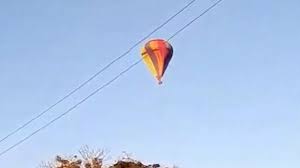News
Hot Air Balloon Crash Brazil: Tragic Incident Highlights Safety Concerns

Introduction to the Hot Air Balloon Crash in Brazil
Hot air balloon crash Brazil incidents are rare but devastating when they occur, drawing immediate public and media attention due to the nature of the transport and its visibility. In a recent and tragic event, a hot air balloon carrying tourists in Brazil crashed, resulting in fatalities and raising serious questions about aerial safety regulations and operational procedures within the country’s tourism sector. The incident not only shocked the nation but also sparked a broader conversation on aviation standards in adventure tourism.
Details of the Crash
The hot air balloon crash occurred near the city of Boituva, in the state of São Paulo, Brazil—an area known for skydiving and aerial sports. The balloon was carrying multiple passengers, including tourists and crew members, when it crashed during what was supposed to be a routine sightseeing flight.
According to preliminary reports from local authorities and eyewitnesses, the crash happened in the early morning hours, a time commonly chosen for balloon flights due to stable atmospheric conditions. However, unexpected high winds or potential equipment malfunction led to the balloon descending uncontrollably before impacting the ground. Emergency services were called immediately, but the crash resulted in fatalities and serious injuries.
Casualties and Survivors
The accident claimed the lives of at least two individuals, including one of the crew members. Several others sustained injuries, some critical, and were rushed to nearby hospitals. Survivors described a terrifying descent, with the balloon basket becoming unstable as strong winds swept across the area. Eyewitness accounts detailed how the balloon seemed to struggle with altitude control moments before the crash.
Families of the victims and survivors are being provided psychological support, and authorities have promised a thorough investigation to determine accountability and prevent future tragedies.
Possible Causes of the Accident
As investigations continue, several possible causes are being examined:
- Sudden Weather Changes: Even though balloon flights typically rely on clear and calm weather, sudden gusts of wind or thermal turbulence can disrupt stability and direction.
- Pilot Error: Balloon pilots must undergo rigorous training. Any lapse in judgment or miscalculation can have serious consequences during descent or landing.
- Technical Malfunction: Failures in the balloon’s burners, envelope integrity, or navigation systems can lead to catastrophic outcomes.
- Poor Maintenance: Like any aerial vehicle, hot air balloons require regular maintenance. Any oversight in safety checks could be contributing factors.
Boituva: Brazil’s Adventure Tourism Hub
Boituva is often referred to as Brazil’s “capital of skydiving,” attracting thousands of adrenaline-seekers each year. The region’s favorable climate and open landscapes make it ideal for activities like skydiving and hot air ballooning. However, this incident has cast a shadow over the local tourism industry, prompting the government to review safety protocols and licensing requirements for aerial operators.
While this area had built a reputation for professionalism and safety, the balloon crash has raised alarms about whether safety standards have kept up with the growing demand.
Government Response and Investigation
The Brazilian Civil Aviation Authority (ANAC) and local police have launched a formal investigation into the crash. Authorities are:
- Inspecting the wreckage for mechanical faults.
- Reviewing the pilot’s qualifications and flight records.
- Analyzing weather data on the day of the incident.
- Interviewing survivors and witnesses for firsthand accounts.
Officials have temporarily suspended balloon flights in the area until the investigation concludes, a move aimed at ensuring public safety and preventing further incidents.
Public Reaction and Media Coverage
The hot air balloon crash in Brazil made national headlines and trended widely on social media platforms. Many expressed condolences for the victims, while others called for tighter regulations and more oversight in aerial tourism.
Several journalists and aviation experts have criticized the lack of unified federal regulation specific to recreational ballooning in Brazil. While basic aviation laws exist, critics argue that they are outdated or insufficient for modern tourism demands.
Safety Concerns in the Hot Air Ballooning Industry
This tragedy reignites the debate over safety in the ballooning industry. Although statistically safer than many forms of aviation, hot air ballooning comes with unique risks:
- Lack of onboard steering control.
- Dependency on weather conditions.
- Limited emergency response mechanisms at high altitudes.
To mitigate risks, many countries require balloon companies to adhere to strict safety codes, including pilot licensing, periodic maintenance, passenger briefings, and weather monitoring. However, enforcement can be inconsistent, especially in tourist-heavy regions where business booms can outpace regulation.
Lessons and Future Measures
The Brazilian government and tourism authorities now face pressure to enforce stricter policies:
- Mandatory GPS Tracking: To monitor flights in real time.
- Emergency Response Training: For both pilots and ground teams.
- Stricter Licensing and Certification: For balloon companies and operators.
- Weather Monitoring Tech: Use of more advanced meteorological tools before takeoff.
Furthermore, there’s growing support for mandatory insurance policies to protect passengers and operators in the event of accidents.
Conclusion
The hot air balloon crash in Brazil is a heartbreaking reminder of the inherent risks involved in adventure tourism. While it is a rare occurrence, its impact is deeply felt—by the families of victims, by the local community, and by the national tourism industry. As investigations continue, the focus must shift toward enhancing safety, enforcing regulations, and restoring public confidence.
Adventure tourism should thrill, not endanger lives. It is now up to Brazil’s aviation and tourism authorities to ensure that such tragedies are never repeated and that the skies above Boituva—and Brazil as a whole—remain safe for all who dare to dream of flight.

-

 Lifestyle2 months ago
Lifestyle2 months agoHappy Fathers Day Dad Wishes Quotes: Express Love the Right Way
-

 Sports2 months ago
Sports2 months agoLuka Modrić: The Midfield Maestro Who Defied the Odds
-

 Tech1 month ago
Tech1 month agoBitcoin Price Could See “Brief Rally Halt”: Here is Why
-

 Business3 weeks ago
Business3 weeks agoUK Sends 2 to Prison for Combined 12 Years for Crypto Scam
-

 Lifestyle1 month ago
Lifestyle1 month agoBobby Sherman: The Teen Idol Who Took the 1960s by Storm
-

 Uncategorized1 month ago
Uncategorized1 month agoWWE Night of Champions: A Celebration of Gold and Glory
-

 Business4 weeks ago
Business4 weeks agoRussia’s Energy Ministry Launches Crypto Mining Register
-

 Business4 weeks ago
Business4 weeks agoCZ Questions TON’s UAE Golden Visa as Official Sources Stay Silent
